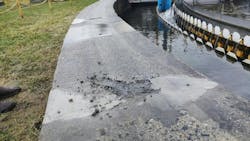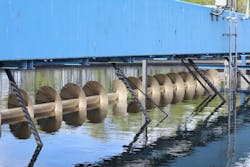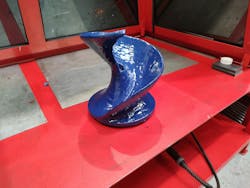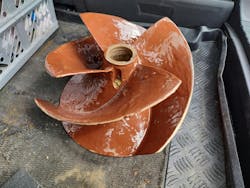Abrasion, wear and chemical attack on tanks and equipment are serious problems for wastewater operators, managers and their utility executives. Concrete tanks and structures experience loss of material, while mechanical systems need regular maintenance to repair damage from abrasive media such as stone and sand.
Raceway damage on primary and secondary settlement tanks
A prime example of this problem is found on the raceways of primary and secondary settlement tanks. They suffer from excessive wear due to cyclic loading from the wheels of a tank’s scraper bridge, which cause heavy loading and friction.
The raceway needs to withstand the full weight of the tank’s scraper bridge. That is a heavy steel structure carrying a rubber scraper that guides sludge at the bottom of the tank into a sump so that it can be pumped away. As the scraper sweeps the base of the tank, a set of wheels repeatedly follows the same route on the tank rim.
Combined with a corrosive chemical atmosphere, this causes wear to initiate, particularly in weak spots such as joints or areas where the texture varies or the level changes. Once started, grains of loose sand and aggregate dislodge from the concrete surface of the raceway, causing the wear to accelerate.
Before long, this can result in problems with the bridge getting stuck or mis-aligned on the raceway. If left unaddressed, it could lead to damage on the scraper bridge or cause process quality issues.
When repairing a worn raceway, it is important to choose the right sort of material so the repair will stand the test of time. During a repair, it is common to rebuild the rim of the tank to its original shape with a product that provides long term resistance to heavy cyclic loading and corrosive chemicals.
One such product is a ceramic polymer compound from a range called MeCaTec. This provides good adhesion to the concrete structure, while creating a surface that is hard and tough enough to withstand the scraper wheels. Different types of compounds are available so it is important to choose the right one based on the conditions, the underlying material and the time available to carry out the repair.
For instance with MeCaCorr 706, a two component epoxy, the coating imparts an effective barrier to protect surfaces from wear, chemical attack and corrosion. A versatile, 100% solids, zero VOC, solvent-free, self-priming technology that offers a tough, cleanable and protective surface coating. Its paint-like viscosity and high film build rheology makes it easy to use by brush or single leg airless spray. This is just one of many coating options available in the market.
Ideally, applicators will coat the entire tank’s edge to ensure the raceway has a smooth, consistent and even surface. Although this type of repair is more costly, it will prevent weak spots and will maximize maintenance intervals. However, budgets do not always allow for full resurfacing, and as such, patch repairs are an alternative in those situations.
Tank interiors
Another area where concrete needs regular maintenance is inside primary and secondary settlement tanks, aeration lanes and channels. These experience significant loss of concrete through the development of cracks and cavities. This creates risk for the plant operator as unattended cracks could lead to untreated sewage leaching through the tank walls into the environment and eventually contaminating groundwater.
Cracks and cavities form due to chemical attack by acids and other compounds in effluent, which can be made worse in some locations inside the tanks by eddy currents.
Once a crack has initiated, it will grow longer and deeper. Even a narrow crack can extend deep into a concrete wall and put the operator at risk of leakage. When repairing cracks, a technician needs to remove surrounding concrete as they need to find the very end of the crack or cavity to be certain that they will repair it fully.
The repair process may call for a combination of different repair compounds, but one solution is MeCaFix 140, a concrete resurfacing and repair compound that is designed for non-structural surface defects. This Kevlar-reinforced polymer compound is moisture tolerant and imparts excellent adhesion to cold and damp concrete. The matrix is designed to achieve maximum build and strength for concrete repairs, to fill deep pits/voids, create coves, and reface worn surface areas.
This is a two-part system, 100% solids, solvent free, zero VOCs technology taking the shape of a non-sagging paste optimal for vertical and overhead applications. The repair material can be applied by trowel, flexible spreaders or grout pump. The application specialist might also see a need to apply a corrosion-resistant coating to the concrete surface to enhance protection and increase the maintenance intervals.
Our field service engineers have experience of repairing cracks that run the full depth of tanks over several metres in length and that extend deep into the concrete walls.
Repairing iron components in pumps, pipework and valves
Cast iron components such as pump impellers and bowls, valves, penstocks and pipework can also experience excessive wear. It is impossible to influence the content of the wastewater flowing in from the catchment so this equipment often needs protection.
Pump impellers are particularly vulnerable to wear. For example, pumps at the inlet works need to handle raw sewage that contains abrasive grit, sand and rag. As a result, they experience heavy wear and need regular maintenance. Elsewhere, fine sands can find their way into the sludge, so the impellers and bodies of sludge pumps can also wear away prematurely, reducing their efficiency.
When it comes to excess wear on cast iron, it is possible to rebuild before reinforcing the surface with a hardwearing coating. That extends the life of the pumps or valves by around five years. However, it is also important to ensure the coating is thin so that the equipment will continue to work as expected, with no loss of flow rate or energy efficiency. To achieve this, coatings can be applied with a brush or a spray technology.
One example we worked on was a cast iron pump impeller at an inlet works. It was losing material due to cavitation and erosion from suspended solids. Having rebuilt the component to its original geometry, workers reinforced the edges of the impeller blades. The service life of the impellers was initially 1.000h, but with the wear-protection solution, the part was still intact after 1.500h.
Another example is a non-return valve (NRV) that was experiencing abrasion, erosion and corrosion from particles of grit and sand, as well as corrosive compounds in the flow. Applicators extended the lifetime of the valve and associated pipework by stripping it down and applying a 1 mm MeCaTec coating inside and out with a special ceramic surfacing polymer to protect and seal the surface.
The repair was delivered in 2019, and in 2024, there are plans to revisit the installation to check how the coating has stood up to the heavy-wear environment.
Quick fix for leaks and cracks
Meanwhile, it is also possible to repair steel components such as motor shafts and bearing sets quickly, as an emergency repair. Vibration or excessive forces can lead to cracks and leaks.
In these cases, components typically need to have a specific size and shape so it is very important to return components to their original geometry quickly. This can be achieved by rebuilding the component with a fast-curing repair paste such as MeCaFix 100. This is a fast-setting metal filled emergency repair polymer (two-component polymer with a 1 to 1 ratio by volume). The working life is three minutes and it is ready to sand within one hour. Repair paste like this is well suited for repairing leaks in tanks, piping, rebuilding seals, stripped threads, keyways and shafts. It is a technique that enables operators to return equipment to service quickly without having to wait for spares, while also extending the service life of key components.
Ultimately, loss of concrete, iron and steel from critical equipment does not need to mean complete replacement for wastewater operators. By calling in a specialist wear-protection engineer, they can repair components and return them to as-new performance while minimizing time out of service.






